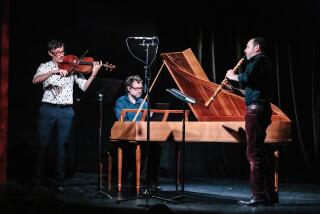MUSIC REVIEW : VIOLINIST LE DIZES-RICHARD AT MUSEUM
The only thing regrettable about the concert Wednesday evening at the County Museum of Art was that so few attended. But those 90 to 100 who heard violinist Maryvonne Le Dizes-Richard and pianist Jean-Claude Henriot in a delightfully varied program found their time well spent.
The violinist, grand prize winner in the International American Music Competition at Carnegie Hall in 1983, played ardently and emotively, keeping a continuous thread of energy going even in the softest passages. She was able to produce a big, bold sound when the score demanded, but her sound always remained pure and focused.
The program opened with Brahms’ D-minor Sontata, where the two musicians capitalized on wonderful phrasing opportunities. A fine sense of teamwork characterized their playing throughout the evening, and nowhere was this more true than in the driving finale of this work.
In deference to their audiences--they are currently touring the United States--Le Dizes-Richard and Henriot featured works by three American composers. The freshness and lean contrapuntal textures of Aaron Copland’s attractive Sonata provided a perfect contrast. The pair delivered a technically clean and expressively rich performance which reminded one of the work’s deserved (if not recognized) status as a masterpiece of the violin-piano repertory.
The two brought verve and panache--albeit very refined panache--to Ives’ idiosyncratic Second Sonata, which cleverly interweaves a bundle of American tunes into a typically Ivesian bi-tonal fabric. The violinist then offered Elliot Carter’s recent “Riconoscenza per Goffredo Petrassi,” a meandering rhapsody in which long, legato lines contrast with static chords and frenetic spiccato passages.
It was fitting, of course, that the French duo closed the program with Ravel’s Sonata. As she had earlier, the violinist played with a marvelously liquid sound and an unfailing sense of direction. The two played the blues-influenced second and third movements with some noticeable restraint, their performance remaining elegant throughout.
Bartok’s Romanian Dances served as the encore.
More to Read
The biggest entertainment stories
Get our big stories about Hollywood, film, television, music, arts, culture and more right in your inbox as soon as they publish.
You may occasionally receive promotional content from the Los Angeles Times.










